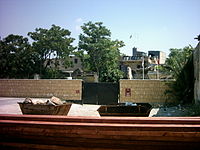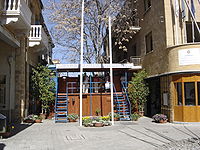- United Nations Buffer Zone in Cyprus
-
The United Nations Buffer Zone in Cyprus runs for more than 180.5 kilometres (112.2 mi) along what is known as the Green Line and has an area of 346 square kilometres (134 sq mi). The zone partitions the island of Cyprus into a southern area effectively controlled by the government of the Republic of Cyprus (which is the de jure government for the entire island save for the British Sovereign Base Areas), and the northern area controlled by the Turkish army.
The term Green Line refers to the cease fire line that de facto divides the island nation of Cyprus into two, cutting through the capital of Nicosia. It was first established in 1964, when Major-General Peter Young was the commander of a "peace force", a predecessor of the present UNFICYP. After stationing his troops in different areas of Nicosia, the general drew a cease-fire line on a map with a dark green crayon, which was to become known as the "Green Line".
The Green Line became impassable following the July 1974 invasion by Turkey which intervened by air, sea, and land, capturing approximately 8% of Cyprus territory in response to a short lived Greek Cypriot coup. When the coup dissolved, the Turkish Armed Forces advanced to capture approximately 37% of the island and meet the "Green Line". The meandering green line marks the southernmost points that the Turkish troops occupied during the Turkish Invasion of Cyprus in 16 August 1974. With the self-proclamation of the internationally unrecognized Turkish Republic of Northern Cyprus, the Green Line became its de facto southern border.
This line is also referred to as the Attila Line on some maps, named after the Turkish code-name for the 1974 military intervention: Operation Atilla. The closed off zone has become a haven for Cyprus' wildlife, an example of an involuntary park.
Traffic across the buffer zone was very limited until 2003, when the number of crossings and the rules governing them were relaxed.
Contents
The buffer zone
The zone stretches for 180 km from the western part of near Kato Pyrgos to the east just south of Famagusta. It cuts through the center of the old town of Nicosia, separating the city into southern and northern sections. There is also a buffer zone around the Kokkina exclave in western Cyprus. The width of the zone ranges from 3.3 metres (11 ft) in central Nicosia, to 7.4 kilometres (4.6 mi) at the village of Athienou.
There is no buffer zone along the common border between the eastern British Sovereign Base Area and the area under Turkish Cypriot control.
The buffer zone is patrolled by the United Nations Peacekeeping Force in Cyprus. Turkish forces built a barrier on the zone's northern side, consisting mainly of barbed-wire fencing, concrete wall segments, watchtowers, anti-tank ditches, and minefields. [1]
The buffer zone is home to some 10,000 people and there are several villages and farms located within. The village of Pyla is famous for being the only village on Cyprus where Greeks and Turks live side by side. Other villages are Dhenia, Mammari, Athienou, Troulli while Lymbia lies partially within the zone.
History
A "security zone" was established after the Tripartite Conference of Geneva in July 1974. Pursuant to United Nations Security Council Resolution 353 (1974),[2] the foreign ministers of Greece, Turkey, and the United Kingdom convened in Geneva, Switzerland on 25 July 1974. According to UNFICYP, the text of the joint declaration transmitted to the Secretary-General of the United Nations was as follows:[citation needed]
A security zone of a size to be determined by representatives of Greece, Turkey, and the United Kingdom, in consultation with UNFICYP, was to be established at the limit of the areas occupied by the Turkish armed forces. This zone was to be entered by no forces other than those of UNFICYP, which was to supervise the prohibition of entry. Pending the determination of the size and character of the security zone, the existing area between the two forces was not to be breached by any forces.
Crossings
Ledra Street, once cut by the Green Line in Nicosia
After a nearly 30-year ban on crossings, the Turkish Cypriot administration significantly eased travel restrictions across the dividing line in April 2003, allowing Greek Cypriots to cross at the Ledra Palace Crossing just outside the walls of old Nicosia. This was made only possible after the decision of the ECHR (Djavit An vs Turkey, Application No.20652/92).[3]
These are the crossings now available :
Republic of Cyprus entrance Turkish Republic of Northern Cyprus entrance Notes Astromeritis
Αστρομερίτης (Greek)Zodeia
Ζώδεια (Greek) Bostancı (Turkish)By car only Ayios Dhometios Metehan Ledra Palace Ledra Palace Ledra Street
οδός Λήδρας (Greek) Lokmacı Caddesi (Turkish)Ledra Street
οδός Λήδρας (Greek) Lokmacı Caddesi (Turkish)On foot only Pyla
Πύλα (Greek) Pile (Turkish)Pergamos
Πέργαμoς (Greek) Beyarmudu (Turkish)Agios Nikolaos
Άγιος Νικόλαος (Greek)Strovilia
Akyar (Turkish)Limnitis
Λιμνίτης (Greek) Yeşilırmak (Turkish)Limnitis
Λιμνίτης (Greek) Yeşilırmak (Turkish)Before Cypriot accession to the European Union, there were restrictions on Green Line crossings by foreigners imposed by the Republic of Cyprus, but these were abolished for EU citizens by EU-regulation 866/2004.[4] Generally, citizens of any country are permitted to cross the line, including Greek and Turkish Cypriots. Passports are required for entry into Northern Cyprus, but they are not stamped.
Incidents
In August 1996, Greek Cypriot refugees demonstrated with a march against what they regard as the Turkish occupation of Cyprus. The demonstrators' demand was the complete withdrawal of Turkish troops and the return of the refugees to their homes and properties.
Another man, Solomos Solomou, was shot by Turkish troops during the same protests on 14 August 1996.[5] Aged 26, Solomou was one of many mourners who entered the Buffer Zone three days after Isaac's funeral, on 14 August to lay a wreath on the spot where he had been beaten to death. Solomou was fired upon by Turkish soldiers at close range as he climbed a flagpole.[6] An investigation followed by authorities of the Republic of Cyprus and the suspects were named as Kenan Akin and Erdan Emanet. International legal proceedings were instigated[7] and arrest warrants for both were issued via Interpol.[8]
See also
- United Nations High Commissioner for Refugees Representation in Cyprus
- No man's land
- Cyprus dispute
- Cypriot refugees
- Sovereign Base Areas Customs
- Pyla
- Louroujina Salient
- Kokkina exclave
- Merlijn Twaalfhoven, did a project in Nicosia with musicians from both sides of the border.
References
- ^ UN starts clearing mines from Cyprus buffer zone
- ^ Text of the UNSC Resolution 353 (1974)
- ^ Zaim M. Necatigil, Kıbrıs Uyuşmazlığı ve AİHM Kıskacında Türkiye: Avrupa İnsan Hakları Komisyonu ve Mahkemesi'nde Kıbrıs Rum Yönetimi ve Kıbrıslı Rumlar tarafından Türkiye aleyhine getirilen davalar (The Cyprus Conflict and Turkey in the grip of ECHR: Cases brought against Turkey by the Greek Cypriot Administration and the Greek Cypriots before the European Commission of Human Rights and the European Court of Human Rights), Ankara, 2006, p.190)
- ^ [1]
- ^ "1 killed, 11 wounded as Turks shoot at Greek Cypriots armed with stones". Associated Press. 15 August 1996. http://nl.newsbank.com/nl-search/we/Archives?p_product=ST&s_site=dfw&p_multi=ST&p_theme=realcities&p_action=search&p_maxdocs=200&p_topdoc=1&p_text_direct-0=0EAF90A39E013EF3&p_field_direct-0=document_id&p_perpage=10&p_sort=YMD_date:D&s_trackval=GooglePM. Retrieved 29 October 2007.
- ^ Kessel, Jerrold (15 August 1996). "Cyprus conflict comes to a boil, U.N., U.S. fault Turkey for Greek Cypriot deaths". CNN. http://www.cnn.com/WORLD/9608/15/cyprus/index.html.
- ^ "Solomou case admitted by Human Rights Court.". Presswire. 9 July 1999. http://www.highbeam.com/doc/1G1-55119529.html.
- ^ Christou, Jean (11 November 1997). "Denktash 'minister' on Interpol list over Solomou killing". Cyprus Mail. http://www.hri.org/news/cyprus/cmnews/1997/97-11-11.cmnews.html.
External links
- Maps of the Buffer Zone, from the UNFICYP website
- Associated Press: Barriers Slowly Eroding for Cyprus
- Beyond the Buffer Zone: One Woman's vision for bringing new life to the No-Man's Land
- Nicosia in Dark and White A photo project about the abandoned buildings around the Green Line
- The United Nations Force in Cyprus Since 1964
- EU Commission report on implementation of the Green Line Regulation (14 July 2005)
- EU Green Line Regulation (29 April 2004)
- [http://www.twaalfhoven.net/la-vie-sur-terre/en-US/merlijn+twaalfhoven/projects/international/long+distance+call+cyprus+2005.aspx Twaalfhoven.net
- Photo's from within the Green Line
Long Distance Call Project in Cyprus, see Documentaries below]
Documentaries
- Echoes Across the Divide (2008) is a documentary film about an attempt to bridge the Green Line with a bicommunal music project performed from the rooftops of Old Nicosia
Districts of Cyprus Categories:- Divided regions
- Separation barriers
- Walls
- Fences
- Geography of Northern Cyprus
- Borders of Cyprus
- Geography of Cyprus
- Foreign relations of Cyprus
- Cyprus dispute
- Foreign relations of Northern Cyprus
- United Nations operations in Cyprus
Wikimedia Foundation. 2010.




